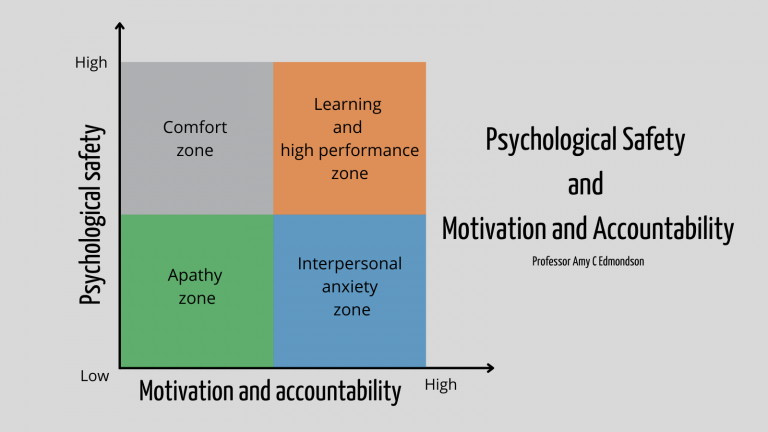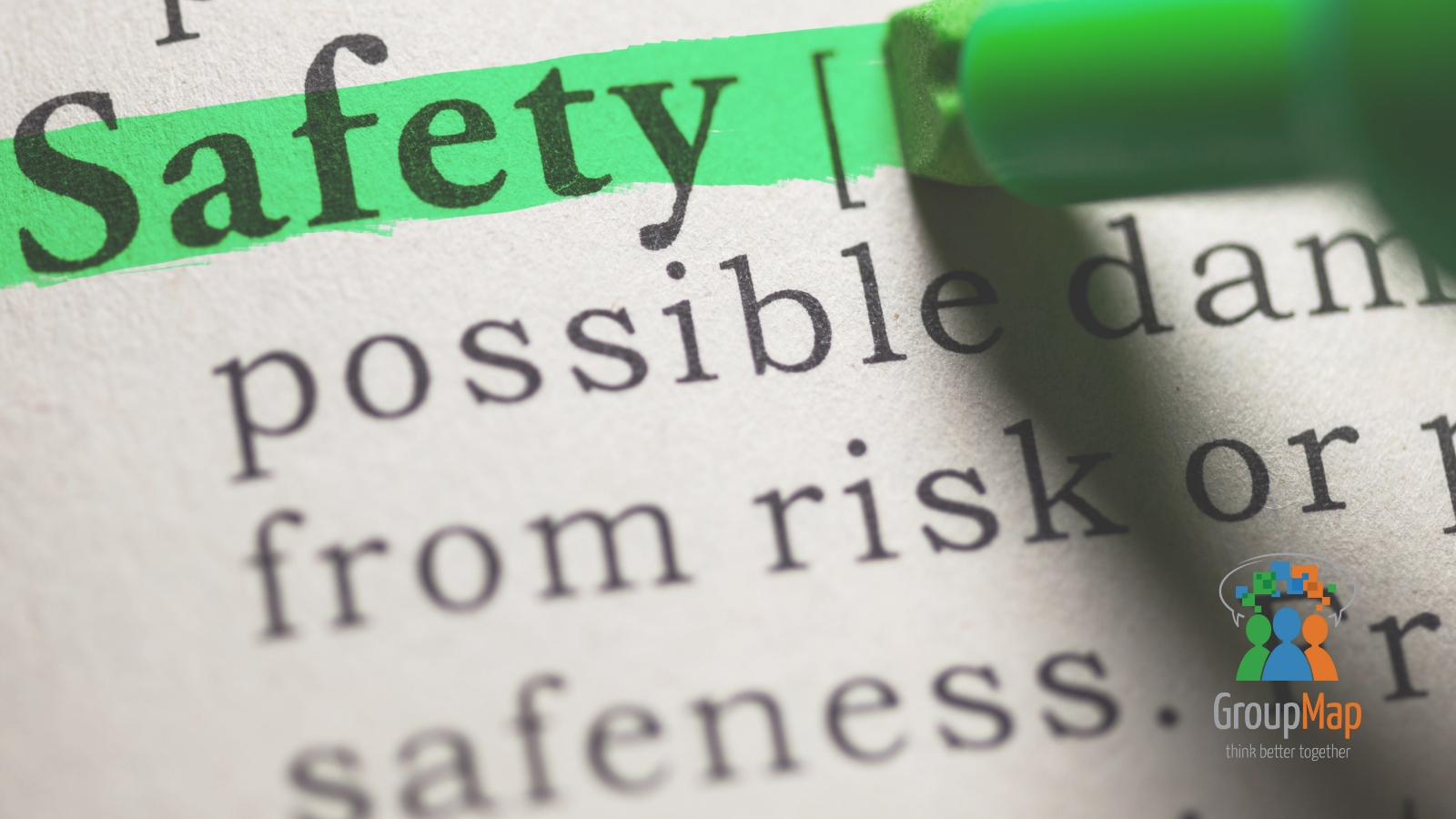What is Psychological Safety?
Psychological safety is a term coined by Professor Amy C Edmondson of Harvard University. It describes a workplace environment free from interpersonal fear. It is an unspoken belief shared by the members of a group that theirs is a safe space in which they can take interpersonal risks.
As humans, we remain hard-wired with a fight or flight response. We assess every environment we encounter for risk. We pick up on even the smallest of cues, process them and decide if we’re in a safe place or we’re not. If we register we’re not safe, one of our two, pre-programmed reactions kick in. We find ourselves feeling we want to fight or flee.
We never stop assessing our environment. Even when we’re at work, we have our feelers out.
In a world of ergonomic furniture, fire drills and hand sanitizing stations, it’s easy to assume workplaces would be at the top of the safety list. But our assessment goes beyond the physical. We gently register smiles, nods and responses. We pick up on eye rolls, sighs and silences. We tune into how our manager and colleagues interact. All to inform the level of risk we perceive to be aligned to our livelihood.
This process is because of our programming. It interprets ‘my job is safe’ as ‘I am safe’. This is the feeling that’s at the core of psychological safety.
When you are working in a psychologically safe space, your feelers don’t register risk. This means your job receives your full focus. Not only that, the absence of fear means you experience a sense of confidence and trust. You feel you have permission to be both honest and candid. You sense that you can speak up and your voice is valued. This means you feel very comfortable sharing ideas, asking questions and offering comments. It is also a space in which you feel it’s ok to make mistakes.
What Isn’t Psychological Safety?
Edmondson makes it clear that psychological safety isn’t a workplace goal. Rather, it is a means of reaching a goal.
A psychologically safe space isn’t –
- one that lacks conflict. In fact, conversations in safe spaces can be quite direct, and very candid.
- one where there’s blind celebration of all ideas. Instead, ideas in safe spaces are still explored and assessed.
- one that lacks errors or failure. It’s a space in which people feel safe to take risks and experiment with different solutions.
Most importantly, psychological safety isn’t an excuse to slack off or say whatever you like. There is still an expectation people will act appropriately within the workplace. They will be thoughtful and considerate. They will be productive and professional.
Why is Psychological Safety Important?
Author Anthony Hood gives two reasons why psychological safety is important –
- Without psychological safety, people are afraid to speak up. When people are afraid to speak up, bad things happen.
- A psychologically safe space supports the bottom line.
A lack of psychological safety means fear is present. Fear impacts thinking and decision making. With fear driving our behavior, self preservation is our priority. This means, in a fearful moment, we overlook the bigger picture to protect ourselves. As a result, bad things happen. Those bad things can include planes flying into mountains or patients receiving the wrong treatment.
Psychological safety also supports the bottom line. As work becomes more complex with less resources, team success requires team members to step up. In doing so they are taking an interpersonal risk. When they suggest a better way forward, it will need to be defended when scrutinized. They are presenting themselves as having expertise, possibly greater than that of their peers and manager. They are not ‘going with the flow’. They are ‘rocking the boat’ for the sake of the team delivering value.
High-performing teams typically feel safe enough to take risks. They also care enough to do so. Edmonson’s work reflected this when she examined the relationship between two dimensions – psychological safety, and motivation and accountability

Four zones were identified –
- Learning and high-performing zone.
An environment of high psychological safety and high motivation is called the learning and high-performance zone. This is the ideal space for a workplace team. They are motivated to take risks and are therefore more likely to experience success.
- Comfort zone.
An environment of high psychological safety and low motivation is called the comfort zone. This could be an environment in which there is no fear, but also no sense of buy-in from the team.
- Interpersonal anxiety zone.
An environment of low psychological safety and high motivation is called the interpersonal anxiety zone. This is a space in which there is a great deal of fear and people are disempowered.
- Apathy zone.
An environment of low psychological safety and low motivation is called the apathy zone. It’s a space in which there’s low performance and very little else.The interpersonal anxiety zone should be of particular concern. This is the zone that can be very impactful on an individual’s mental health and therefore wellbeing.
How Does Psychological Safety Improve Collaboration?

Psychological safety improves collaboration in three important ways.
Firstly, psychological safety addresses groupthink. Groupthink is when our desire for cohesion influences group decision-making. We don’t want to appear different from the group, so we favor ideas that will help avoid conflict so consensus can be quickly reached. It occurs when we are feeling unsafe.
Secondly, it also addresses hesitancy. When we’re unsure we will hesitate before sharing suggestions and ideas. In that moment of hesitation we may self-edit or self-censor. When we find ourselves in a psychologically safe space we readily offer our ideas and feedback. This also means more ideas are shared.
Finally, psychological safety supports the evolution of ideas. Without the fear of things such as a judgment or adverse action we freely offer and embrace feedback. We are actively curious and open to possibilities. We will explore the potential of suggestions. This drives creativity and innovation.
In short, psychological safety supports collaboration because we’re not held back by fear. We’re not weighed down by excessive worries about others’ opinions regarding our actions. Our energy isn’t directed to thinking of ways to avoid the potential for embarrassment and other threats. Psychological safety gives us the freedom to engage, explore and create.
What Does a Psychologically Safe Meeting Space Look Like?
Meetings offer a window into the level of psychological safety of a team or group. If the group feels safe, the following four key signs will be observed.
- Participation is high. When meeting attendees feel safe, they happily engage in the meeting. They will offer ideas and suggestions. They will be curious about the topics being discussed. They will ask questions to clarify and confirm their understanding.
- Mistakes will be mentioned. When meeting attendees feel safe they will acknowledge and own their mistakes. Their errors will be used as a learning opportunity because psychologically safe spaces are the ones in which learning takes place.
- Feedback is requested. When meeting attendees feel safe they will actively request and offer feedback. Feedback is seen as constructive. It is understood it is a reflection of the idea and not the person suggesting it.
- There will be conflict. When meeting attendees feel safe they will disagree. It is understood that healthy dissent can stimulate neural pathways and spark creativity. Attendees will share their concerns regarding an idea. They will offer alternative ideas. They will explore the merits of all suggestions and reach a consensus.
How Do I Know if My Team Feels Safe?
The best way to find out if your team feels psychologically safe is to ask them. Of course, that’s easier said than done. This is because the way someone is asked about psychological safety can, in fact, affect that sense of safety.
For example, if a manager asks a team member if they feel safe, they are highly likely to say that they do. That’s not because they do really feel that way, but rather because they simply want to shut down a potentially uncomfortable conversation. Claiming they feel safe is the easiest way to do this.
Edmondson shaped seven key questions to help assess the level of psychological safety felt by a group.
- If you make a mistake on your team, is it held against you?
- Are you able to bring up problems and tough issues?
- Do people on the team sometimes reject others for being different?
- Is it safe to take a risk?
- Is it difficult to ask other team members for help?
- Do people on the team deliberately act to undermine your efforts?
- Are your unique skills and talents valued and utilized?
The questions help to assess the level of group-based fear. The more fear that’s apparent, the less safe the group feels.
As with our earlier example, asking these questions directly to a group member will distort their response. The best way of capturing feedback to these questions is to allow people to respond anonymously. If time allows, it’s also valuable to allow for asynchronous responses. This means people don’t feel rushed or pressured in any way.
As time passes and team members come and go, it’s important to revisit these questions. The shared experience of existing team members can be daunting for new people. Not only that, what makes people feel safe will change over time.
What Can I Do to Build a Psychologically Safe Space?

While it’s everyone’s responsibility to foster an environment of psychological safety, it is tethered to the top of an organization. Leaders and managers need to model behavior that others will follow.
- Acknowledge mistakes. Keep the saying “to err is human” front of mind. Show that everyone makes mistakes and that the important thing is to learn from them and grow. It’s also valuable to acknowledge those that helped to identify and fix the error. This reinforces the importance of the team.
- Be available to the team. Listen to their feedback, concerns, and questions. Listen to their suggestions. Be curious and ask questions that give your team a platform to speak.
- Respond mindfully. Owning up to mistakes isn’t easy and it should be supported rather than punished. Responding with annoyance, anger or frustration will only diminish psychological safety. It may even teach people to hide their mistakes or blame others.
- Ask for help and offer it. It’s important that asking for help isn’t seen as a sign of incompetence. Instead, it’s an indication of being self-aware. If someone has a particular experience, make the most of them by asking them to assist. If an important deadline is looming, ask others to contribute to lower stress levels. If someone is struggling, offer to help out. Help is a symptom of good teamwork and collaboration.
- Facilitate guidelines. They could range from meeting ground rules to a team agreement. Allow the people working together with the opportunity to set the parameters in which they will operate. This will give people the chance to define the behavior that helps them feel safe.
- Nominate a devil’s advocate. Appoint someone to be critical of ideas rather than supportive. This distances an individual from any criticism they may issue as well as helps to ensure all ideas have rigor.
Everyone can contribute to psychological safety by –
- Saying what you would want to hear in the workplace. If you were new, had made a mistake or done a great job, what would you want to hear from your colleagues? Well, say it. Connecting with empathy and demonstrations of support will foster a sense of trust and safety.
- Keeping things in context. You could be a part of a project group, a workplace team, or a committee member. You are a member of a group that has a purpose so don’t make it personal.
- Expressing gratitude. The positive effects of gratitude range from better sleep to an increase in life satisfaction. Expressing gratitude is a way of acknowledging the help that was received. As we’ve said before, help is a sign of collaboration and good teamwork.
Make your Meetings Safer with GroupMap
Supporting psychological safety does take some effort but it’s well worth the effort – and GroupMap can make it easy.
Groupmap supports the effective delivery of workshops, meetings, teaching, and training. It boasts features specifically designed to overcome barriers to collaboration, foster a safe environment and increase meeting participation.
You can start straight away with any one of the 80+ templates.
Use GroupMap to run your next online session today.

